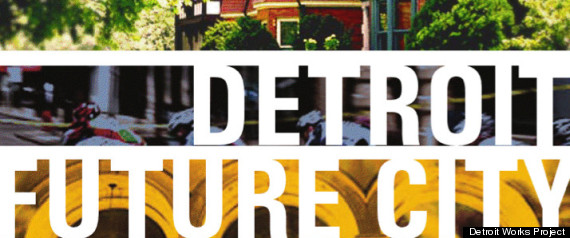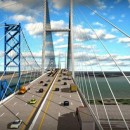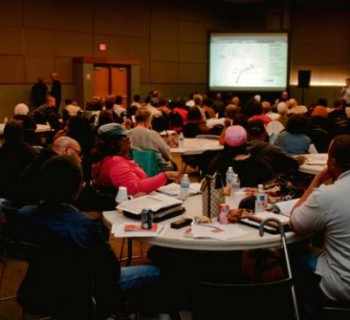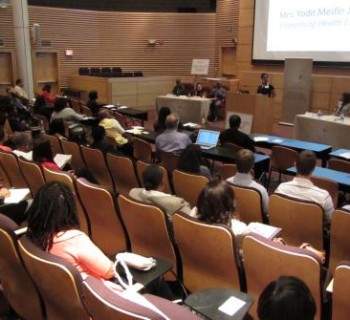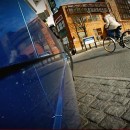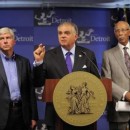Update: Kresge Foundation President and CEO, Rip Rapson, announced Jan. 9 that Kresge will commit $150 million toward implementing the Detroit Future City planning framework over the next five years.
"Over the next five years we're going to dedicate every single dollar we spend in Detroit to this plan," Rapson said.
Detroit Economic Growth Corporation President, George Jackson, said the Kellogg and Kresge Foundations have also contributed $3 million for a "lean but world-class" project management office for the framework's day-to-day implementation.
"The framework is unprecedented in its depth, comprehensiveness and its reach," Rapson said. "This is the most sophisticated, nuanced and relevant framework that has been developed in America in the last 25 years. The framework is owned, held and grounded in the community and it is the kind of scaffolding that will determine our way of living into the future."
The project involves billions of dollars in investment over the next several years, and although it's a massive undertaking, when it's broken down, it's not as overwhelming as it appears. Those investment dollars will be multiplied if they're invested and used strategically, according to Rapson.
"Success breeds success," he said.
***
DETROIT — In a city that's become known more for its bad traits than its good ones, a team of designers, planners and managers turned two years of work and planning and public conversations into an ambitious report that outlines strategies and ideas that could create a true Detroit 2.0.
The massive report, titled "Detroit Future City," is the product of thousands of hours of research, public engagement and analysis. Over 150,000 interactions were considered when developing the 350-page plan, which took more than two years to complete.
"Detroit Future City" suggests ways in which the city can best use their glut of public land; create jobs; maintain livable neighborhoods; maintain and upgrade infrastructure; and maintain a high level of community engagement.
Dan Pitera, who is director for the civic engagement facet of the Detroit Works Project Long-Term Planning effort, said those conversations and interactions are the backbone of "Detroit Future City" and they need to continue in order for the framework to succeed.
"'Detroit Future City' is a framework for decision making as we move forward," Pitera said. "It is about creating a place for all Detroiters and amplifying the quality of life for all."
The LTP team was steadfast on referring to it as a framework, saying the term "plan" doesn't accurately describe the findings, and that a framework simply describes the context in which decisions should be thoughtfully made and executed.
"It's a framework because we recognize that change is constant and we needed to provide a tool for [various] sectors to help Detroit move forward," said Toni L. Griffin, director of the LTP's technical planning facet.
She also said the framework is the most comprehensive planning project in the country. "Not only unparalleled in Detroit, it's unparalleled anywhere. It's unprecedented. Everything here came from a blending of community and technical expertise."
By aligning assets with opportunity, the LTP team says they have established a constitution that will help leaders innovate by enabling an efficient and coordinated use of resources.
Detroit Works Project Phase II: "Detroit Future City"
There are five recommendations the LTP team has highlighted from within the framework, which were developed in response to what they saw as the most pressing and common issues residents were facing in the city.
1. Economic Growth:
The city should place strategic investments in high-density employment districts and use place-based strategies to create investment and employment corridors, starting with districts already demonstrating significant success.
Many of the economic growth recommendations in the report are based on creating jobs in what they call "employment clusters," or areas of the city with a high concentration of jobs, like downtown. The LTP team identified seven such districts, and while they account for half of the city's employment, they occupy only 15 percent of the city's area.
Economic Growth Project Director Teresa Lynch said the city has been a leader in information technology for the passed decade and it's an aspect of the city, especially downtown, leaders need to embrace and leverage.
The report magnifies the importance of cultivating minority business enterprises and activating underused industrial areas in combinations with entrepreneurship and a creative workforce, saying these assets can be coordinated to create "new economy clusters," where further investment may occur.
Economic Growth Project Director Teresa Lynch said the city has been a leader in information technology for the passed decade and it's a characteristic of the city leaders need to embrace and leverage. One area of particular interest in this section was the idea of creating an expedited permitting process for potential small-business owners, which would ease the often cumbersome process and encourage more small-business startups.
By and large, "Detroit Future City" intends for the economic growth strategies "to grow Detroit's economy in a way that is equitable for all Detroiters, supports economic sectors and can attract new residents and businesses."
2. Land Use:
The report charges leaders to examine our existing landscapes and turn them into innovative, 21st Century infrastructure assets. The Land Use chapter in the report describes feasible strategies that were developed upon the current status of the city's land and identifies many types of land use within different levels of scale and purpose.
"We need more innovative land use," said Dan Kindead, Land Use Project Manager for LTP team. "We need to think differently about neighborhoods — we need to enact innovative, active reform and create a sustainable range of density in the city."
Part of the team's land-use solution is to create a map and database of up-to-date information that's accessible throughout the network of eight organizations that have a role in managing the foreclosed land. They also recommend revising zoning ordinances in order to promote development and growth.
 The report stresses the importance of transportation connectivity, especially considering 61 percent of employed Detroiters work outside of the city and 21 percent do not have a car. Better and more transportation options can alleviate stressful two-hour commutes on traditionally unreliable buses. On the contrary, transportation options are important to suburban commuters as well, who comprise 70 percent of the city's workforce.
The report stresses the importance of transportation connectivity, especially considering 61 percent of employed Detroiters work outside of the city and 21 percent do not have a car. Better and more transportation options can alleviate stressful two-hour commutes on traditionally unreliable buses. On the contrary, transportation options are important to suburban commuters as well, who comprise 70 percent of the city's workforce.
Other suggestions for productive infrastructure projects include complete streets programs, which accommodate all vehicles and users of the road, employing transit-oriented development tactics and building "blue and green infrastructure," which can help filter the city's air and water reservoirs and improve environmental quality.
3. Neighborhoods:
According to the report, Detroit should support a an array of new and existing neighborhood types, and leverage them as blueprints for future development, providing the direction for specific areas throughout the city while addressing current and future land conditions and quality-of-life issues.
"Detroit Future City" illustrates ideal and replicable neighborhoods, describing them as green, mixed-use, dense, walkable and should have the potential to be reinvigorated through the fusion of art and industry, through projects like "live-make spaces."
Creating a wide range of sustainable residential densities and a way to make those neighborhoods desirable are among the top priorities outlined in the report. And because there are many different neighborhoods in Detroit, creating an equitable solution involves accommodating diverse lifestyles and providing their respective amenities.
4. City Systems:
This element illustrates the importance of progressing toward an affordable, efficient and sustainable city through service reform and by adapting and upgrading the systems, like recycling, that move us and supply our water and energy.
It outlines how to best use public lands to create an open-space system for the city that can be used to improve water, soil and air quality, provide ample recreational activities and a habitat for wildlife.
"We must realign city systems in ways that promote areas of economic potential, encourage thriving communities, and improve environmental and human health condition," the report states. "We must focus on sizing the networks for a smaller population, making them more efficient, more affordable and better performing."
The framework suggests services be "right-sized" in order to reconcile network capacity with demand but also ensures core services are delivered to all areas of Detroit, including high vacancy areas. Robertson said it's not about reducing service but rather looking at a more cost-effective way to deliver them.
These ideas target infrastructure renewal, and illustrate how landscape can be used as infrastructure and how Detroit can benefit from a more diverse and robust transportation system.
Lawrie Robertson, City System project director for LTP, said technology can help cities deliver essential services more efficiently. Part of the framework directs the city to provide high-speed data networks and to establish a government platform that optimizes its delivery of services.
The framework suggests services be "right-sized" in order to reconcile network capacity with demand but also ensures core services will still be delivered to all areas of Detroit, including very low-density areas. Robertson said it's not about reducing services but rather looking at a more cost-effective way to deliver them.
5. Transportation:
Riders in the city have long suffered from unreliable and late or totally absent buses. The report emphasizes the need for a viable citywide transportation system, which is currently used by less than 10 percent of residents. Authors suggest creating faster connections between work and home and that development should be concentrated in centers and neighborhoods to encourage more trips on foot and bike.
Of course, the volume of cyclists and pedestrians correlates heavily with public safety, and one framework provision also charges leaders to improve lighting efficiency by reducing the number of lights and outfitting remaining ones with high-efficiency LED lights.
Governor Rick Snyder recently signed legislation authorizing a reformed municipal lighting authority, which will also help keep street lights on in the Detroit.
These five major recommendations, combined with a sixth facet of relentless civic and public engagement, say framework engineers, has the potential to be robust and dynamic enough to handle the problems the cash-strapped city faces today, Griffin said.
Detroit Works Project Almost Didn't Work
Before "Detroit Future City," the Detroit Works Project had a more than rocky beginning when Mayor Dave Bing first introduced it in 2010.
After a series of failed community outreach events and meetings, he restructured it into two different programs — one for long-term planning and research, and another to provide short-term assistance in distressed neighborhoods.
In its infancy, residents accused Mayor Bing of wanting to relocate them into denser urban cores, leaving belts of greenways that didn't require typical residential services like waste management. The city has said it will not use eminent domain to claim any homes or properties, but Bing said relocating residents would be part of the land-use reform.
"It has been very difficult to get from where we were two years ago to where we are today," Bing said today. "I think the beauty of this is that we had so many people that came to the table because we care for the city and the people."
Residents remained skeptical about the strategic framework, and community meetings were often packed and uncivil at times.
Detroit 2013 - 2063
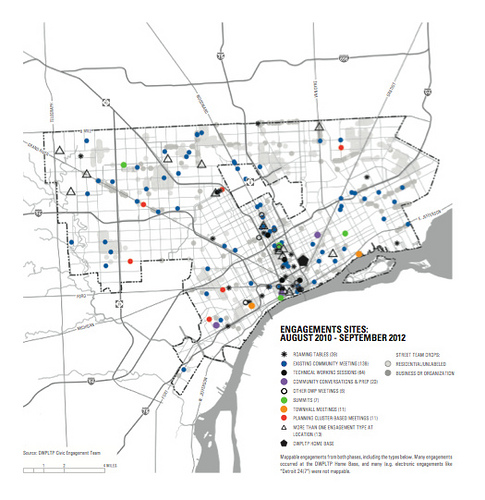 Now that the LTP team has finished and published their research, there must be some entity to implement it, right?
Now that the LTP team has finished and published their research, there must be some entity to implement it, right?
That task will now become the responsibility of Detroit Economic Growth Corporation President, George Jackson. As its manager, the DEGC will be responsible for finding and leveraging funding and figuring out how to best execute the framework strategies.
The LTP team also suggests that a consortium of leaders be established to help execute the framework's recommendations.
"Detroit Future City" authors said just because the report is finished doesn't mean their work is — the framework requires continuous civic participation and cooperation between regional leaders. Detroit Works Project staff are currently working with stakeholders to help them understand the framework in its entirety.
"We recommend that [leaders] use this as a tool collectively," Griffin said. "There needs to also be important regulatory reforms — what gives investors confidence is that there's an underlying set of rules that everyone plays by. It's very important to keep the momentum and address permitting and zoning, that make it easier to live and open a business."
"Starting [today] we have to make this stuff happen. It may take a while to root, but this is really for your 10 year old in 10 years," she said.
"We will see change tomorrow, and five and ten years from now," Pitera said. "We do not have to wait 50 years for change because there are so many places of innovation in this. We are being a model not just for American cities, but for cities across the world."
As innovative as this framework may be, its success is still contingent on widespread public support and functional government entities that are willing to collaborate and get their fingernails dirty. Ideas and research can only define the boundaries and color of the door, but it's the act of walking that gets us through it.



